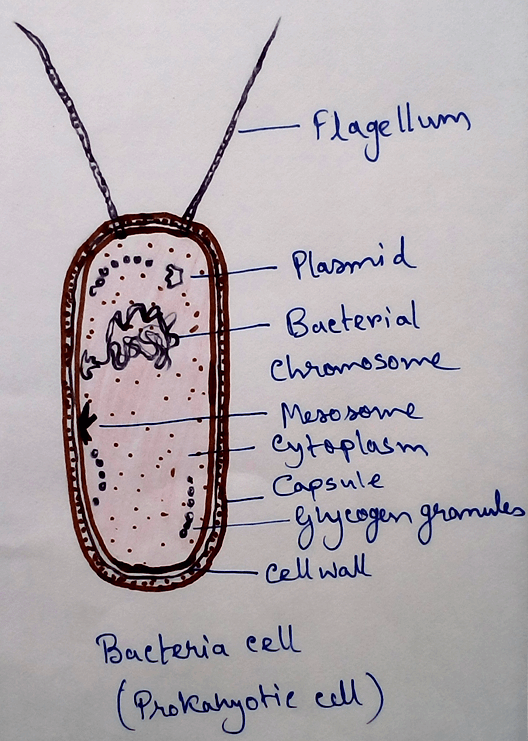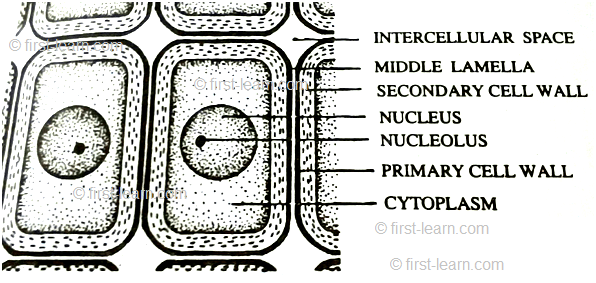Prokaryotic Cells
Scientist Dougherty first classified the cells in 1957. Cells are classified on the basis of structural organisation of their nucleus into two main types that are prokaryotic cells and eukaryotic cell. The term “pro” means premitive and “karyoplasms” means nucleus.
Examples of prokaryotic cells are - different types of bacteria (cocci, bacillus, spirilum) etc.
Definition of prokaryotic cell - Prokaryotic cells are the organisms that do not have membrane bound organelles and well defined nucleus, nucleoid is present instead of nucleus.
Definition of eukaryotic cell - Eukaryotic cells are the organism in which membrane bound organelles, well defined nucleus is present in it. Their genetic material is well placed and proper DNA is present.
Prokaryotic cells - prokaryotic cells are premitive plant cells that having the simplest organisation. Prokaryotic cells include bacteria, blue green algae, mycoplasma or PPLO that is pkeuro pneumonia like organisms, rickettsiae and spirochaete. Prokaryotic cells are smaller than eukaryotic cells in size. Cells of prokaryotes contain mass of protoplasm and is covered by cell covering. Each cell is bounded by a complex cell wall beneath which the plasma membrane lies. Plasma membrane surrounds the protoplasm of the cell. In some places plasma membrane invaginated to form internal membranous structure. Protoplasm of prokaryotic cells are not well defined like eukaryotic cell. Means protoplasm is not divided into nucleus and cytoplasm. In eukaryotic cells nucleus contains genetic material which is membrane bound but in prokaryotic cells genetic material is localised in a discrete region called nucleoid or genophore or chromatin body. It is made up of DNA threads. Here DNA is not complexed with his tone proteins and it does not form chromosome. That means true chromosome are not formed. The nucleoid is not separated by the delimiting membrane. Thus the genetic material of the prokaryotic cells called nucleoid. Here in prokaryotic cell DNA threads are divided by binary fission.
Organelles
of prokaryotic cell - Prokaryotic cells do not have any membrane bound
organelles like mitochondria, plastids, endoplasmic reticulum, Golgi body etc.
In the prokaryotic cell plasma membranes are folded in different regions to
form mesosome or are called desmosome which may contain respiratory enzymes and
it may function as mitochondria.
Pigments - Photosynthetic pigments are present in vesicles like chromatophores, disc like thylakoids, tubules like lamellae. These together are considering as plastids. As true plastids are not present in the prokaryotic cells.
Ribosome in prokaryotic cells - Ribosome are 70S in prokaryotic cells. The bigger subunit is 50s and the smaller subunit is 30s. Ribosomes and inclusion bodies are freely scattered on the cytoplasm. Ribosomes are not associated with a membranous organelles as they are not present.
Cell wall – Prokaryotic cell wall is made up of nitrogen containing complex of compound that is made up of mucopeptide in nature.
Microtubules - Microtubules are not present in the prokaryotic cells.
Flagellum of prokaryotic cell - flagella is simple and 9+2 organisation is absent. It is a whip like structure associated with locomotion of prokaryotes.
Pilli of prokaryotic cell - Different types of Pilli are present in prokaryotic cell .
In some cases glycoprotein’s are present.
From Prokaryotic Cells to HOME PAGE
Recent Articles
-
What Is Plasma? | Blood Plasma | Proteins | Nutrients | Cholesterol
Nov 07, 25 10:29 AM
Blood is a mobile fluid which is a connective tissue and is derived from the mesoderm like cell any other connective tissue. Colour of blood is reddish and that flows inside the blood vessels by means… -
Disorders of Respiratory System | Tuberculosis | Pleurisy | Emphysema
Oct 28, 25 11:39 PM
Tuberculosis is very common disease and is caused by a type of bacteria called Mycobacterium tuberculosis. This disease causes different trouble in the respiration and infection of several parts of th… -
Regulation of Respiration | Respiratory Centres | Inspiratory Area |
Oct 14, 25 12:13 AM
Respiratory Centre is the area that controls the rate of respiration and it is observed to be located in medulla oblongata and pons. Respiratory Centre has the following will dispersed components like… -
Explain Transport of Gases | External Respiration | Tissue Respiration
Oct 09, 25 11:35 PM
In humans gaseous exchange is completed in the following ways the steps are - External Respiration or Breathing - Breathing in false taking in of Oxygen and giving out of carbon dioxide in the body. M… -
Kind and Number of Teeth | Location of Teeth in Mouth | Care of Teeth
Sep 11, 25 12:52 AM
Kind and Number of Teeth
















New! Comments
Have your say about what you just read! Leave me a comment in the box below.